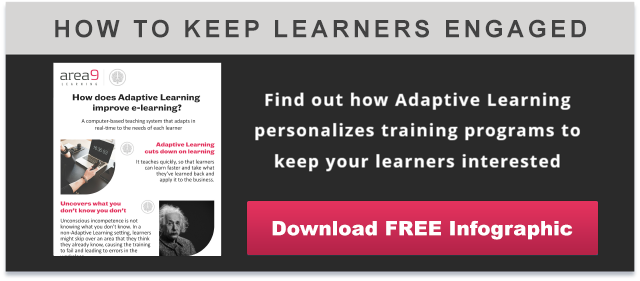Employees want to do training, but don’t always see it as a priority - especially because online training is often boring.
If your employees have this attitude towards company training, the negative impact on your business’ bottom line grows exponentially with the more employees you have. You may ask, is it even possible to engage thousands of employees in training where they can actually learn something? And even then, how can you track that their effective training yielded a positive return on investment for your company?
The key to engaged learning - and tracking the impact of that engagement - is Adaptive Learning.
Adaptive Learning is the Answer to How to Engage Employees in Training
Adaptive Learning improves e-learning effectiveness through higher engagement in three ways.
- Adaptive Learning personalizes to the learner. Everyone learns differently. What makes Adaptive Learning different from other e-learning platforms is that Adaptive Learning knows this. Instead of teaching the same thing, in the same way, to every learner, Adaptive Learning personalizes to what each learner needs and never wastes time trying to teach them something they already know. The result is that employees feel more engaged and connected to the process of their learning. They’re less distracted, and they can more easily hold themselves accountable when it feels like, “Finally, someone is actually paying attention to me.”
- Adaptive Learning uses formative assessment. Formative assessment is essentially, teaching by asking questions. Adaptive Learning systems use formative assessment to measure the learner’s knowledge base as well as their confidence with the material and adjusts and readjusts the learning objectives and lesson content to meet the learner’s needs. A majority of learners find that they have a more positive learning experience when they learn through formative assessment because they can feel the system adapting to them.
- Adaptive Learning works within your existing learning management system. You were probably attracted to the concept of e-learning because it suggested the opportunity to lower costs by providing lots of training to many
people regardless of the expense of travel, space and time. Except, e-learning as you know it didn’t work. That’s because in order for e-learning to work, you need to understand how the brain works, and how every brain learns new information differently. Traditional learning, and no other learning platform can do this, except an Adaptive Learning engine that combines cognitive science with computer science.
What Does Engaged Learning Mean for Your Business?
Higher engagement means no more “check the box” exercises. But it also means that their training will be more effective; a higher level of engagement, focused only on what they need to know gives employees the best chance (as proven with Area9 data) to apply what they’ve learned to your business in the form of productivity and profit. And the best news is, you don’t have to re-do everything you’re already doing: you just need to empower your existing e-learning platforms by injecting into them an effective adaptive engine.
Improve Your E-Learning Outcomes with Adaptive Learning
Higher engagement and improved productivity are some of the many benefits of Adaptive Learning. Discover more of the benefits of Adaptive Learning with this free infographic and find out:
- How to optimize learning time
- How to uncover what you don’t know, and
- How Adaptive Learning better tracks learner progress










